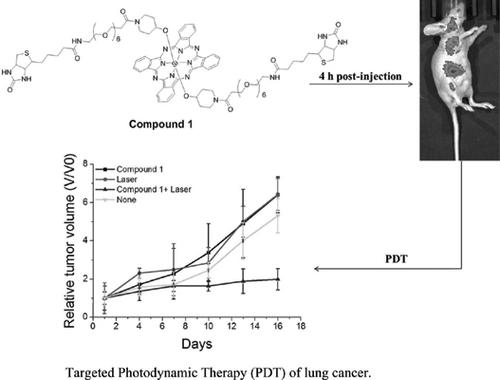Current Pharmaceutical Biotechnology ( IF 2.8 ) Pub Date : 2021-02-28 , DOI: 10.2174/1389201021666200510001627 Wenyi Dong 1 , Ke Li 1 , Shijie Wang 1 , Ling Qiu 1 , Qingzhu Liu 1 , Minhao Xie 1 , Jianguo Lin 1

|
Background: Lung cancer is the leading cause of cancer-associated mortality in the world. Traditional cancer therapies prolong the life expectancy of patients but often suffer from adverse reactions. Photodynamic Therapy (PDT) has been recommended as a treatment option for lung cancer in several countries, due to its non-invasive procedures, high selectivity and weak side effects.
Objective: We have designed and synthesized a biotin receptor-targeted silicon phthalocyanine (IV) (compound 1) which showed a good therapeutic effect on biotin receptor-positive tumors. Since the overexpression of Biotin Receptor (BR) is also present in human lung cancer cells (A549), we explored the therapeutic properties of compound 1 on A549 xenograft tumor models.
Methods: The selectivity of compound 1 toward A549 cells was studied with a fluorescence microscope and IVIS Spectrum Imaging System. The cytotoxicity was measured using the MTT assay. In vivo anti-tumor activity was investigated on the nude mice bearing A549 xenografts.
Results: In vitro assays proved that compound 1 could selectively accumulate in A549 cells via the BR-mediated internalization. In vivo imaging and distribution experiments showed that compound 1 could selectively accumulate in tumor tissues of tumor-bearing mice. After 16 days of the treatment, the volumes of tumor in the PDT group were obviously smaller than that in other groups.
Conclusion: This study demonstrates that compound 1 is a promising photosensitizer and has broad application prospects in clinical PDT of lung cancers.
中文翻译:

生物素化硅酞菁对肺癌的靶向光动力疗法(PDT)
背景:肺癌是世界上与癌症相关的死亡率的主要原因。传统的癌症疗法延长了患者的预期寿命,但常常遭受不良反应。由于光动力疗法(PDT)的非侵入性程序,高选择性和较弱的副作用,因此在一些国家被推荐作为肺癌的治疗选择。
目的:我们设计并合成了靶向生物素受体的酞菁硅(IV)(化合物1),对生物素受体阳性肿瘤具有良好的治疗效果。由于人肺癌细胞(A549)中也存在生物素受体(BR)的过表达,因此我们探讨了化合物1在A549异种移植肿瘤模型中的治疗特性。
方法:用荧光显微镜和IVIS光谱成像系统研究化合物1对A549细胞的选择性。使用MTT测定法测量细胞毒性。在带有A549异种移植物的裸鼠上研究了体内抗肿瘤活性。
结果:体外测定证明化合物1可通过BR介导的内在化选择性地积聚在A549细胞中。体内成像和分布实验表明,化合物1可以选择性地蓄积在荷瘤小鼠的肿瘤组织中。治疗16天后,PDT组的肿瘤体积明显小于其他组。
结论:这项研究表明化合物1是一种有前途的光敏剂,在肺癌的临床PDT中具有广阔的应用前景。

























 京公网安备 11010802027423号
京公网安备 11010802027423号